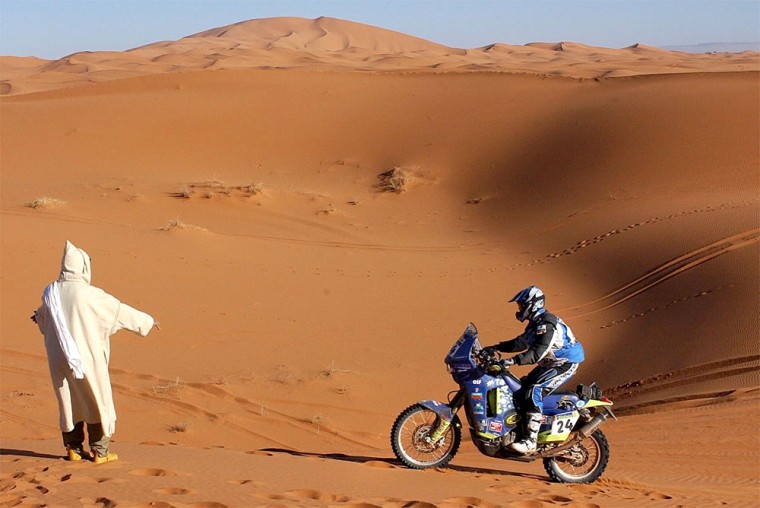Braving the motorcycle-swallowing dunes, the bone-crunching crashes and the occasional camel in the road, drivers of the Paris-Dakar rally faced a new threat Wednesday as the race returned to Africa proper: terrorism.
Saharan nations pledged thousands of troops to guard against any attacks, by either bandits or terrorists, along a redrawn route that skirts the desert home of Islamic extremists linked to al-Qaida.
In 2003, the rally’s 25th anniversary, it skipped both Paris and Dakar for the first time, as well as all of West Africa, because of fears over security.
This year, organizers, competitors and hosts are determined to get the Paris-Dakar rally back on track.
After all, “it’s called the Dakar,” said Roger Kalmanovitz, a race spokesman accompanying the rally along its 6,920.4-mile route down two continents. Competitors — from 40 countries this year — race a mixture of 4x4 vehicles, buggies and motorcycles.
Back to Africa
The decision by organizers to bring Paris-Dakar back through West Africa to Senegal’s capital was taken after a poll of competitors, which is at a 14-year high of 607 entrant vehicles, Kalmanovitz said.
“They wanted to return to the sand dunes of Mauritania and the ambiance of black Africa,” Kalmanovitz said, speaking by phone from a stage stopping point in Ouarzazate.
“The heat, the people who line the track, who are exuberant in a way you don’t see anywhere else — it’s this ambiance that is unique to West Africa,” he said.
The Paris-Dakar saw its first run in 1978, launched by French racer Thierry Sabine after he became lost in the Libyan desert — and was so enraptured by the experience that he made it an annual event.
Exemplifying the danger accompanying the race’s glamour, Sabine died when his helicopter crashed in the 1986 race.
Drivers launched this year’s race in snowy France on New Year’s Day. Japan’s Hiroshi Masuoka, who is going for his third straight win, has the overall lead after Wednesday’s seventh stage.
A long and winding road
From Europe, the course undulates across the dunes and canyonlands of West Africa, crossing Morocco, Mauritania, Mali and Burkina Faso under the eyes of lone, turbaned herdsmen on hilltops or curious children on mules.
Competitors will finish Jan. 18 outside Dakar at Lac Rose, or Pink Lake, which takes its unique color from a type of algae.
On Wednesday, the souped-up vehicles and their banged-up drivers — already bearing taped ribs and stitches from crashes during the seven previous days — jolted along the longest stage of the route, 656 miles.
At the border, they crossed into Mauritania — straddling Arab and black Africa on the Sahara’s southern edge.
African and Arab traders were waiting. “I make a living for myself thanks to the sale of artifacts to rally participants,” said Mohamed Lamine Ould, who had moved his stand up to the edge of Mauritania’s capital in anticipation of racers’ first pass through the country since 2002.
He said he nearly went out of business because of the rally’s absence.
Good for business
Nearly 20 jets and 30 helicopters carry the vast, movable city of the rally from stage to stage, and West Africa’s nomads made their annual fortunes off it for two decades.
In 2003, racers bypassed black Africa entirely, skimming a northern route across Libya into Egypt instead. Organizers at the time explained the rerouting only vaguely, citing conflicts in Central African Republic and Congo — countries as far from Dakar as Ukraine is from Paris.
“In Africa, there are many complicated countries,” organizer Hubert Auriol said then.
“It cut our lives,” said Hassan Ould Seyed, who had made a livelihood from scavenging vehicles abandoned by competitors.
To help bring the rally back, Mauritania’s Arab-led government promised protection along the route in the country. Security sources, speaking on condition of anonymity, said the force would number 5,000.
In Mali, the rally’s next stop, 800 armed military and paramilitary forces will guard the way. “We have taken the maximum measures so that the event takes place in the best conditions,” Mali national rally support coordinator Dramane Diarra told The Associated Press.
Watching out for bandits, or worse
Guards will be vigilant for the dangers of past years — including bandits, who robbed rally participants at gunpoint in Mauritania in 1999.
But the new measures have as much to do with international terrorism as with Sahara bandits.
The route will skip its one-time route through Algeria, home to an Islamic extremist group ranked among the most threatening of those linked to al-Qaida. Algeria blamed the group for the 2003 kidnapping of about 25 European tourists, one of whom died before the captives were freed.
This year, racers also will steer clear of northern Mali and of northern Mauritania, where the government is combating what some outside security experts say are al-Qaida cells.
“The problem is this zone bordering the three countries has always served as a redoubt for criminals, bandits and recently for terrorists,” said Moulaye Najim, director of the “Hot Spots” weekly, which surveys crisis points in French West Africa.
Organizers hope to limit the risk to spectators as well — by restricting racers to speeds to as low as 20 mph through villages. The limit is meant to prevent deaths among local drivers and children, who are used to the slow-speed world of camel and mule travel and sometimes stray into the paths of the racers.
